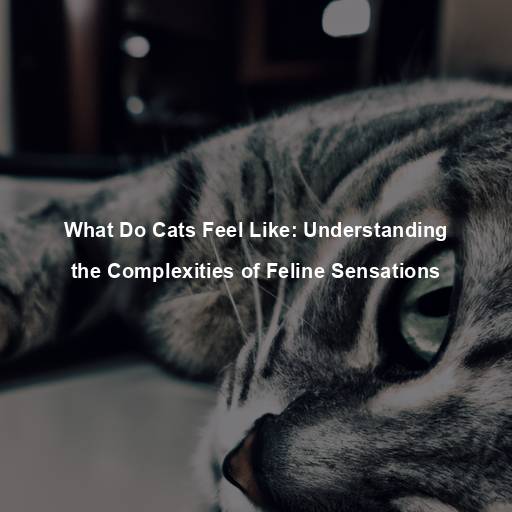Why Are Cats White?
Last Updated on October 23, 2023 by Evan
Contents [hide]
- 1 Understanding the Fascinating World of Cat Coat Colors
- 1.1 Genetics: The Key to Understanding Cat Coat Colors
- 1.2 The Role of Genes in White Coat Color
- 1.3 Partial Albinism: A Cause of White Coat Color
- 1.4 Ancestral Influences: The White Cat Connection
- 1.5 Deafness and White Coat Color
- 1.6 The Beauty of White Cats: Their Endearing Qualities
- 1.7 White Cats in Mythology and Folklore
- 1.8 Celebrating the Diversity of Cat Coat Colors
- 1.9 Temperature-Sensitive White Spotting
- 1.10 Dilution Genes and White Coat Colors
- 1.11 Crossbreeding and White Coat Colors
- 1.12 White Cats as a Result of Selective Breeding
- 2 Understanding the Perception of White Cats in Society
- 3 Caring for White Cats and Their Unique Needs
- 4 Appreciating the Diversity of Cat Coat Colors
- 5 FAQs – Why are cats white?
- 5.1 Why are some cats white?
- 5.2 Are all white cats considered albino?
- 5.3 Why do some white cats have different colored eyes?
- 5.4 Can white cats experience health issues related to their coat color?
- 5.5 Are there specific breeds that are more likely to have white cats?
- 5.6 Can a white cat change its fur color over time?
- 5.7 Are white cats always purebred?
Understanding the Fascinating World of Cat Coat Colors
Cats come in a wide array of coat colors and patterns, from the strikingly beautiful and vibrant to the elegantly understated. Among these variations, the color white holds a special allure. White cats possess a unique charm that captivates our hearts, but have you ever wondered why some cats are white? Join us on a journey to unravel the mysteries behind the enchanting world of cat coat colors, as we explore the reasons why cats can be white.
Genetics: The Key to Understanding Cat Coat Colors
Have you ever wondered why some cats come in the most mesmerizing shades of white? Well, the answer lies within the mystical world of genetics. You see, a cat’s coat color is no ordinary affair. It’s a complex dance of pigments that adds a burst of enchantment to their furry canvas.
The Role of Genes in White Coat Color
White coat color in cats is primarily determined by a gene called the “White Spotting Gene” or “S” gene. This gene influences the distribution of melanocytes, the cells that produce melanin, throughout the cat’s body. Cats with the “S” gene can exhibit varying degrees of white markings, ranging from small patches to entirely white coats. However, it is important to note that not all white cats possess the “S” gene, as other genetic factors can also contribute to their coat color.
Partial Albinism: A Cause of White Coat Color
There’s something captivating about those enchanting white cats, and it turns out their coat color is more than meets the eye. Enter partial albinism, a genetic quirk that throws a curveball into the production of melanin. This intriguing condition leaves these feline beauties with a striking lack of pigmentation in their hair, skin, and eyes, resulting in a mesmerizing palette of white or light-colored fur. Adding to the enigma, their eyes often dazzle in hues of blue or green, as if they hold secrets hidden within their depths.
Ancestral Influences: The White Cat Connection
Another fascinating aspect of white cat coat colors lies in their ancestral influences. The presence of white coat color in cats can be traced back to their wild ancestors, such as the African wildcat and the European wildcat. These ancient feline species possessed the genetic variations that gave rise to white coat colors in their descendants. Through generations of domestication and selective breeding, these genetic traits have been passed down, leading to the existence of white cats in our homes today.
Deafness and White Coat Color
Did you know that there is an enchanting link between the color of a cat’s coat and their ability to hear? It seems that white cats, especially those with mesmerizing blue eyes, are more susceptible to deafness. This peculiar connection stems from the fascinating world of genetics. Genes responsible for their stunning white fur can unexpectedly impact the development of their inner ear, resulting in hearing difficulties.
The Beauty of White Cats: Their Endearing Qualities
Beyond the scientific explanations, white cats possess a certain charm that sets them apart. Their pristine coats exude an air of elegance and purity, captivating our attention and melting our hearts. White cats often symbolize innocence, grace, and serenity. Their enchanting presence brings a sense of tranquility to our lives, making them beloved companions and cherished members of our families.
White Cats in Mythology and Folklore
Across the annals of time, an enigmatic aura surrounds white cats, captivating the hearts and minds of humanity. Steeped in mythology and folklore, these majestic creatures have long been revered as bearers of good fortune, luck, and even divine intervention. Ancient Egyptians paid homage to the goddess Bastet, a mesmerizing deity portrayed with the head of a lioness fused seamlessly with the slender frame of a domestic feline, believed to bless mortals with protection and abundant prosperity. Digging deeper into the tapestry of traditions, Japanese folklore unveils the majestic “Maneki-neko” or “Beckoning Cat,” an ivory-hued feline with a single paw gracefully lifted, symbolizing a powerful invitation to embrace a life brimming with destiny’s blessings.
Celebrating the Diversity of Cat Coat Colors
From the mystical allure of white cats to the captivating charm of their colorful counterparts, the diverse array of cat coat colors is a sight to behold. With each hue and pattern boasting its own distinctive beauty, it’s time we celebrate the kaleidoscope of feline aesthetics. Whether they don a sleek ebony coat, showcase a graceful tabby design, sport a vibrant calico ensemble, or radiate purity in snowy white, these enchanting creatures bring boundless joy, unwavering companionship, and a torrent of endless entertainment to our lives. So let us embrace the mesmerizing diversity that these furry friends offer, and cherish the inexplicable, yet undeniable bond we share with them.
As we conclude our exploration into the world of white cats, we hope you have gained a deeper understanding of why some cats are white. Through the intricate interplay of genetics, ancestral influences, and the captivating allure of these feline companions, we have unraveled the mysteries behind their coat colors. So, the next time you encounter a white cat, take a moment to appreciate the beauty and wonder that they bring into our lives. ## The Influence of Other Factors on White Coat Color
Temperature-Sensitive White Spotting
There’s more to white coat color in cats than meets the eye. Besides genetics and partial albinism, another fascinating factor at play is temperature-sensitive white spotting. This intriguing phenomenon is observed in certain breeds, like the Siamese and Himalayan cats, where the coat color is influenced by the temperature during their development in the womb. The cooler extremities, such as the ears, paws, and tail, display darker pigmentation, creating a remarkable contrast with the lighter body.
Dilution Genes and White Coat Colors
The enchanting world of feline genetics reveals yet another mesmerizing secret: the influence of dilution genes on the captivating shades of white coat colors in our beloved cats. These elusive genes, known as the “dilute” or “blue” gene, possess the power to transform the intensity and saturation of their majestic fur. By harmonizing with other genetic elements, these dilution genes delicately orchestrate a stunning metamorphosis, presenting us with a lighter, diluted rendition of the original coat color, tantalizingly resembling ethereal whites and delicate pastels. This awe-inspiring phenomenon bewitches us especially when we marvel at the graceful Russian Blue or the magnificent Chartreux, where the enchanting dilute gene paints a mesmerizing canvas of a silvery-gray coat that at times mystifies our senses, hinting at the elusive realms of pure white.
Crossbreeding and White Coat Colors
Crossbreeding between different cat breeds can also contribute to the occurrence of white coat colors. When cats with different coat colors are bred together, the genetic traits responsible for white coat color can be inherited and expressed in their offspring. This can lead to the appearance of white cats in breeds where it is not typically seen. Crossbreeding can introduce a fascinating mix of coat colors and patterns, including white, creating a diverse and visually stunning feline population.
White Cats as a Result of Selective Breeding
Throughout history, the fascinating art of selective breeding has woven its way into the tapestry of feline genetics, leaving us awe-struck by the intricate patterns and mesmerizing hues that adorn the coats of today’s cats. An enchanting manifestation of this harmonious dance between human ingenuity and nature’s whimsy can be found in the captivating realm of white-coated feline beauties. Delving into this enigmatic world, we discover the Turkish Van and the Snowshoe breeds, magnificent creatures whose snowy coats glisten with elegance, embodying the profound impact we have had on the kaleidoscope of coat color diversity. The captivating journey of feline genetics continues to bewilder and delight, leaving us in a state of blissful perplexity as we witness the breathtaking array of colors that grace our feline companions.
Understanding the Perception of White Cats in Society
Superstitions and White Cats
Across the tapestry of time, the enigmatic presence of white cats has woven intricate threads of folklore and mystique. Mysterious and beguiling, these felines have become unwitting vessels of both fortune and fear, ensnaring the hearts and minds of diverse cultures. From the cherished bearers of prosperity and positive energy in certain realms, to the whispered whispers of dark sorcery and ill fate in others, the dichotomy surrounding these ethereal creatures remains shrouded in enigma. Yet, amidst this intricate tapestry, it is essential to grasp that these superstitious beliefs are mere reflections of cultural customs, drifting further from the shores of reality.
Stereotypes and Misconceptions
White cats, particularly those with blue eyes, have often been portrayed in media and popular culture as mysterious or even evil. These stereotypes perpetuate misconceptions and can contribute to the mistreatment or misunderstanding of white cats. It is essential to challenge these stereotypes and approach white cats, like any other cat, with love, care, and respect. By dispelling misconceptions, we can appreciate the unique qualities and beauty that white cats bring into our lives.
White Cats as Symbols of Innocence
On a more positive note, white cats are often associated with innocence and purity. Their pristine white coats evoke a sense of serenity and tranquility, making them symbols of purity in various cultures and artistic representations. White cats have also been featured in literature and art, symbolizing purity of heart and embodying the qualities of grace and elegance. These positive associations further contribute to the fascination and admiration surrounding white cats.
White Cats in Pop Culture
Throughout history, the enigmatic aura surrounding white cats has woven its way into the fabric of popular culture, captivating the minds of cinephiles, bookworms, and feline enthusiasts alike. Remarkable fictional feline figures like the mischievous Cheshire Cat, crafted by the brilliant Lewis Carroll, or the ever-cunning Snowball from “The Simpsons,” have successfully etched their paws in our collective consciousness. These mesmerizing and symbolic white cats have emerged as charismatic icons, effortlessly bewitching the masses and leaving an indelible mark on our imaginations.
Caring for White Cats and Their Unique Needs
Sun Protection for White Cats
White cats are more prone to sunburns and skin damage due to their lack of pigmentation. This makes it crucial for owners to prioritize the protection of their feline friends from the fierce and unforgiving rays of the sun. By minimizing their outdoor ventures, creating shady havens, and applying specially formulated sunscreen for pets, white cat owners can shield their precious companions from the perplexing dangers of ultraviolet (UV) rays.
Deafness in White Cats
As mentioned earlier, white cats, particularly those with blue eyes, are more prone to congenital deafness. Cat owners should be aware of this association and take appropriate precautions to ensure the safety of their deaf or hearing-impaired feline companions. Providing a safe indoor environment, using visual cues for communication, and consulting with a veterinarian for regular check-ups can help address the unique needs of deaf white cats.
Coat Maintenance for White Cats
We all know that white cats are, undoubtedly, the epitome of elegance and grace. But let’s be real for a moment – maintaining that pristine appearance requires some serious TLC. The struggle is real, my friends. White fur can be a magnet for dirt, stains, and all sorts of discoloration that can leave us scratching our heads in perplexity.
Appreciating the Diversity of Cat Coat Colors
Ultimately, the enigma surrounding the prevalence of white cats takes us on an enthralling exploration of genetics, ancestral legacies, and the role of humanity in shaping these feline features. The intricate interplay of these elements adds to the kaleidoscope of coat colors that exist within our feline friends, and renders the captivating allure of white cats all the more perplexing. Let us, as ardent cat devotees, embrace this tapestry of diversity, cherishing the distinctive beauty of each cat and the indescribable happiness they bring to our lives. Whether ebony, striped, multicolored, or pure white, these four-legged creatures continue to bewitch our souls, serving as constant reminders of the profound bond between humans and their felicitous feline companions.
FAQs – Why are cats white?
Why are some cats white?
Did you know that cats, like humans, can also have albinism? Albinism is a fascinating genetic mutation that affects the production of melanin, the pigment responsible for our skin, hair, and eye color. In the case of cats, this condition manifests as stunning white fur. Though truly albino cats are rare, their unique presence in the feline world never fails to captivate our curiosity and wonder.
Are all white cats considered albino?
No, not all white cats are considered albino. While albinism results in completely white fur, there are other genetic factors that can cause white fur in cats. One such factor is a genetic variation called the dominant white gene. Cats with this gene have white fur, but they still have normal pigmentation in their skin and eyes.
Why do some white cats have different colored eyes?
Some white cats with blue eyes or odd-colored eyes have a condition known as heterochromia. Heterochromia occurs when there is a difference in the coloration of the iris (colored part of the eye). This can happen due to a lack of pigmentation in one or both eyes. It is more commonly seen in white cats with albinism, but it can also occur in other cat breeds or individuals.
Yes, some white cats are more prone to certain health issues or conditions. Cats with albinism may have sensitive skin that is more susceptible to sunburn and skin cancer. They may also suffer from vision problems due to the lack of pigmentation in their eyes. It is important to provide proper sun protection and regular veterinary care for white cats to minimize these risks.
Are there specific breeds that are more likely to have white cats?
While white cats can be found in various breeds, there are certain cat breeds that are more prone to having white individuals. Some examples include the deaf white cats commonly found in the American Shorthair and Persian breeds. Additionally, the Turkish Van breed is known for having a predominantly white coat with colored markings on the head and tail.
Can a white cat change its fur color over time?
No, once a cat’s fur has grown in white, it will generally remain white throughout its life. The coloration of a cat’s fur is primarily determined by genetics and will not change naturally. However, some cats may develop stains or discoloration on their fur due to external factors such as environmental dirt, food, or certain medications. These stains can be superficial and can often be cleaned or washed off, restoring the cat’s original white fur color.
Are white cats always purebred?
No, white cats can be found in both purebred and mixed-breed populations. While certain cat breeds may have a higher likelihood of producing white cats, it is not exclusive to purebred lines. White fur is a result of various genetic factors, and cats with white coats can be found in different breeds and mixed-breed populations.







